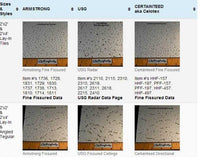Look up. Is there a piece of cardboard or towel stuffed in your ceiling air conditioner vent? Is the air from your overhead ceiling diffuser blowing down on you?
 Whether it is summer or winter, overhead air vents and air diffusers can create an uncomfortable environment for you and your co-workers. Due to the nature of a commercial building HVAC systems design, some rooms or areas are prone to receiving too much air or CFM’s (cubic feet per minute). This extra air can blow down on you in the summer and make you cold. It can also make you overheat in the winter. What to do? You can try to duct tape a piece of cardboard to the face of the diffuser but this will ruin the esthetic of the office and look unsightly.
Whether it is summer or winter, overhead air vents and air diffusers can create an uncomfortable environment for you and your co-workers. Due to the nature of a commercial building HVAC systems design, some rooms or areas are prone to receiving too much air or CFM’s (cubic feet per minute). This extra air can blow down on you in the summer and make you cold. It can also make you overheat in the winter. What to do? You can try to duct tape a piece of cardboard to the face of the diffuser but this will ruin the esthetic of the office and look unsightly.
Use an Air Diverter
A quick and esthetically pleasing solution is called a Ceiling Air Diverter. These one-piece inserts are designed to redirect air towards a window, wall or even a co-worker, if you want to be petty . Conversely, the air diverter can also be installed so that the HVAC air from the diffuser gets directed towards you instead of away, if your body temperature runs on the hot side in the summer or cold side in the winter.
The original Ceiling Air Diverter was built in a rectangular shape, constructed of .090” gauge hi-impact polystyrene, with measurements of 11-3/4” x 23-3/4” and a low-profile depth of 2-1/2”, designed to fit snugly between the T-Bar system and the diffuser itself. The weight of the diffuser keeps the diverter in place, all without tools or mechanical supports such as screws, magnets or clips. As the popularity and need grew, a triangular diverter, also known as a Corner Air Diverter was introduced, again, installed easily, without tools or mechanical support. Both versions blend in nicely with the existing diffuser and they look like a standard and stocked part of the original ceiling system. The air diverters are easy to remove for routine cleaning. Another key benefit of the Air Diverter is that it does not restrict the flow or CFM of the HVAC system, unlike a restrictive Air Damper that is install in the duct system. Building management and building engineers are pleased with this solution because it doesn’t interfere with the delicate balance of the HVAC system.
Note: The Ceiling Air Diverter is not designed to be installed on a ceiling diffuser more than one at a time. We don’t want to stop air from flowing, merely to re-direct it.
Other Air Diverter Products
Necessity is the mother of invention. Customers requested an air diverter for a linear diffuser, as known as a strip line vent. These linear diffusers are usually found in larger spaces and are placed around the perimeter of the room or venue. The linear air diverter was invented to help push fasting moving air back towards the wall or windows, keeping the draft to a minimum. There are two styles of linear air diverters on the market, one version deflects air at a 45-degree angle, great to push air towards the wall or window. A 90-degree deflection linear air diverter also exists, designed to push air along the flat plane of the ceiling so that it eventually falls gently towards the ground but not all at the same time or the same position. Again, building engineers and pleased with the Linear Diverter because of its non-restrictive specifications, not interrupting the flow of air from the system.
Linear Air Diverters are built in various lengths and sizes to accommodate multiple lengths of stocked and installed linear diffusers. The most common length is 48”. However, 24”, 60” and 72” linear vents are also found on ceilings throughout commercial spaces. Also, depending on the need for CFM’s, linear diffusers come in widths ranging from 2” through 6.75” and sometimes even 12” wide. The 45-degree deflecting Linear Air Diverter is constructed of a clear/frosted transparent high impact acrylic based multipolymer compound. The 90-degree Linear Air Diverter is built from white high impact polystyrene. Both are made to withstand multiple removals and installs during cleaning and routine maintenance.
Again, with necessity grew a 2’x2’ square, 4-Sided Air Diverter which will direct and push air from the HVAC system across the ceiling in all four directions, which allows the air to gently fall down into the work space, thereby resulting in a comfortable working environment.
Add a Filter For Better Air Quality
Filters were eventually added to the 4-sided air diverter creating an easy tool to help filter out contaminates such as dust and mold from the air conditioning system. Filtered Air Systems are easily installed with pre-fixed magnets that attach to the metal grid system. Plastic safety clips are supplied to guarantee a secure fit. Not only does the Filtered Air System clean the air as it leaves the ceiling diffuser, the system also helps stop black soot from building up on the ceiling tiles surrounding the vent.
Speaking of dust and soot on ceiling tiles, we have found another product that will also remedy the unsightly buildup on ceiling tiles surrounding the HVAC vents. The Ceiling Air & Dust Deflector, available in clear or white acrylic will solve this problem. We often see supermarket ceilings with black soot buildup around the vents.
The original Ceiling Air Diverter was designed in 2010 by a ceiling cleaning and restoration specialist who saw the need to help office workers stay comfortable. The “jerry rigged” cardboard and duct tape temporary fix was just that, temporary, because adhesive on the duct tape would soon fail after one seasonal transfer from hot to cold air, leaving a tail of tape hanging from the ceiling.
Residential Air Diverters
Homeowners, hey we didn’t forget about you. The traditional residential air conditioning vent is approximately a square of 12”x12” or a rectangle, that is 14”x10” or 12” x 8”. We mentioned a Corner Air Diverter earlier is this article. The Corner Air Diverter can be customized and cut down to fit and deflect air from your ceiling vents. Since the residential vent is installed in sheetrock or plaster board, mechanical support such as screws and plastic wall anchors are supplied to help secure the Custom Corner Air Diverter to the ceiling. And don’t forget, the air diverter can be installed in the opposite direction so that you can get more air towards you instead of less, your call.
Again, with calls from consumers and the growing appeal of residential Ductless or Mini Split systems, a need for an attachable deflector to help direct the fast-moving air from the vents of the ductless AC blower. The 45-degree Linear Air Diverter can be cut down and attached using a good quality double sided tape.
The entire line of air diverter products will install easily, most do not need tools or mechanical support.
A quick and easy fix to stay comfortable so you can ditch the sweater and hoodie.


